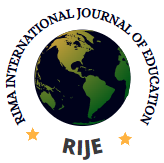Achieving Gender Equity for Sustainable Development: Challenges for School Administrators
Ikati Lawrence
Department of Educational Foundations, Faculty of Education, Niger Delta University, Wilberforce Island, Amassoma, Bayelsa State
Abstract
The current economic and financial downturn has created much concern over its effect on the achievement of sustainable development. The lack of attention to achieving gender equality will not only slow down development but will jeopardise all efforts. While progress is observed in ensuring gender balance in education, which is a key instrument for human emancipation, access to resources, employment opportunities, and representation in decision-making levels are key areas that can transform the lives of women worldwide and contribute to the achievement of developmental needs of a nation. Yet, despite this increasing awareness everywhere, women and girls today face gender-based discrimination. By contrast, where women and girls are treated as inferior to men and boys, a vicious circle of limited education will create undesirable situations that will impede meaningful development. The trust of the paper is to unravelled the barriers to ensuring gender equality in the attainment of secondary education and the challenges and strategies that school administrators can implore to address the situation. The paper concluded with suggestions; one of which is for government(s) to organize enlightenment campaigns to create better awareness for society to understand the importance gender equality.
Keywords
Gender Equality, Administrative Strategies, School Administration
Reference
Achyut P., Bhatla N., Khandekar S., Maitra S., and Verma R.K. (2011) Building support for gender equality among young adolescents in school: Findings from Mumbai, India (New Delhi: International Center for Research on Women).
Bank, J.B. (1997). Introduction: Some paradoxes of gender equality in schooling. Boulder: Lynne Rienner Publishers.
Barker, G. et al (2012) ‘Boys and education in the Global South: Emerging vulnerabilities and new opportunities for promoting changes in gender norms’, Thymos: Journal of Boyhood Studies, 6(1-2), 137- 150.
Brighhouse, H. & Unterhalter, E. (2002). Primary goods, capabilities, and the development target for gender equality in education. Retrieved January 2016 from http~~//www.Edmunds.cam.ac.uWvhi/Nussbaum
Chaabouni, B. & Bouhamed, H. (2006). What good education for girls? Retrieved April 5, 2008
Dunne, M. (2007) ‘Gender, Sexuality and Schooling: Everyday Life in Junior Secondary Schools in Botswana and Ghana’, International Journal of Educational Development 27, 499- 511.from www.agora.forwomeninscience.com
Durrani, N. (2008) ‘Schooling the “other”: the representation of gender and national identities in Pakistani curriculum texts’, Compare, 38(5), 595-610
Floro, M. & Wolf, J. M. (1990). The economic and social impact of girls’ primary education in developing countries. US agencies for international development. Washington, DC Hill,
- In A. & King, E. M. (1993). Women’s education in developing countries: Barriers, benefits, and policies. World Bank. Hopkins University Press. Baltimore and London. author.
Hill, M. A. & King, E. M. (1993). Women’s education in developing countries: Barriers, benefits, and policies. World Bank. Hopkins University Press. Baltimore and London.
ILO (2012b) ‘Indigenous women workers: with case studies from Bangladesh, Nepal, and the Americas’, ILO Working Paper 1/2012 (Geneva: ILO).
Klasen, S. (2003). The impact of gender inequality in education and employment on economic growth in the Middle East and North Africa. Lamanna, University of Munich.
Loncove, J.A. (2008). Growth, girls’ education, and female labor: a longitudinal analysis. 41(2)45. Retrieved April 5, 2008, from www.proquest.umi/pqdwev?index
Menon-Sen, K. (2005). Taking action: achieving gender equality and empowering women. Gender disparity in primary and secondary education. MDG Report Retrieved January 3, 2009 from www.unmimmenniumproject.org/documents/gender~omplete.pdf
Mitchell, M., et al. (2014) ‘What works in tackling homophobic, biphobic and transphobic (HBT) bullying among school-age children and young people? Evidence review and typology of initiatives’ NatCen: Government Equalities Office.1-29.
Morrow, V. and Singh, R. (2015) ‘Children’s perceptions of punishment in schools in Andhra Pradesh, India’, in (ed.) Gender Violence in Poverty Contexts: The Educational Challenge (London: Routledge).
Murphy-Graham, E. (2009) ‘Constructing a new vision: Undoing gender through secondary education in Honduras’, International Review of Education, 55: 503-521.
Nandita, B., Achyut, P., Khan, N. and Walia, S. (2014) Are Schools Safe and Gender Equal Spaces? Findings from a baseline study of school-related gender-based violence in five countries in Asia (Washington D.C. / Plan International).
National Democratic Institute (2016) Retrieved on 12th March 2016 from https://www.ndi.org/what-we-do/gender-women-and-democracy
Parkes, J. (ed.) (2015) Gender Violence in Poverty Contexts: The Educational Challenge (London: Routledge).
Parkes, J. and Heslop, J. (2013) Stop Violence Against Girls at School: A Cross-Country Analysis of Change in Ghana, Kenya and Mozambique (London: Action Aid International).
Rufa’I, R. A. (2000): “Gender inequality in education as revealed by the 1991 census data: implication to curriculum planning”. Journal of Research in Special Education. 4 (3) 251- 266
Sackey, H.A. (2005) ‘Female labor force participation in Ghana: the effects of education’. AERC Research, Africa Economic Research Consortium, Nairobi. 150
Stromquist, N. (2006) ‘Gender, Education and the Possibility of Transformative Knowledge’, Compare,36 (2), 145-161.
Srivaster, G.(2016). Retrieved 24th April 2017From http://www.ncert.nic.in/departments/nie/dws/modules/RMSA_Module.pdf
UNESCO (2015) Gender and EFA 2000-2015: Achievements and Challenges (Paris: UNESCO). UNESCO (2009) Promoting Gender Equality in Education: Bangkok Asia and Pacific Regional Bureau
USAID, (2008). Management Systems International (Prime Contractor). Report Development of Office of Women in Development by the EQUATE Project,
World Bank (1995b). Priorities and strategies for education: a World Bank review. Washington, D.C.
